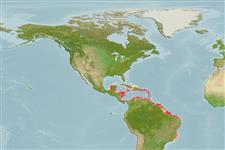>
Eupercaria/misc (Various families in series Eupercaria) >
Sciaenidae (Drums or croakers)
Etymology: Odontoscion: Greek, odous = teeth + Greek, skion, skiaina = barbel, red mullet (Ref. 45335).
More on author: Cuvier.
Environment: milieu / climate zone / Tiefenbereich / distribution range
Ökologie
seewasser riff-verbunden; tiefenbereich 1 - 30 m (Ref. 9710). Tropical; 22°N - 25°S, 92°W - 36°W (Ref. 56868)
Western Atlantic: Florida, USA and Cuba to Brazil. Absent in the Bahamas.
Size / Gewicht / Alter
Geschlechtsreife: Lm ? range ? - ? cm
Max length : 30.0 cm TL Männchen/unbestimmt; (Ref. 26340); common length : 18.0 cm TL Männchen/unbestimmt; (Ref. 3702); max. veröff. Gewicht: 13.70 g (Ref. 118626)
Rückenflossenstacheln (insgesamt) : 11 - 14; Rückenflossenweichstrahlen (insgesamt) : 22 - 25. No barbels; brownish silver with dark dots on scales; a large black spot at base and axil of pectoral fins (Ref. 13442).
Body shape (shape guide): fusiform / normal.
Inhabits caves and crevices or among corals (Ref. 9710). Solitary or in groups (Ref. 9710). Feeds at night mainly on shrimps and small fishes (Ref. 9710), and their larvae (Ref. 13442). Secretive and wary (Ref. 9710).
Life cycle and mating behavior
Geschlechtsreife | Fortpflanzung | Ablaichen | Eier | Fecundity | Larven
Robins, C.R. and G.C. Ray, 1986. A field guide to Atlantic coast fishes of North America. Houghton Mifflin Company, Boston, U.S.A. 354 p. (Ref. 7251)
IUCN Rote Liste Status (Ref. 130435: Version 2025-1)
Bedrohung für Menschen
Harmless
Nutzung durch Menschen
Fischereien: weniger kommerziell
Tools
Zusatzinformationen
Download XML
Internet Quellen
Estimates based on models
Preferred temperature (Ref.
123201): 26.7 - 28.2, mean 27.6 °C (based on 568 cells).
Phylogenetic diversity index (Ref.
82804): PD
50 = 0.6250 [Uniqueness, from 0.5 = low to 2.0 = high].
Bayesian length-weight: a=0.00851 (0.00415 - 0.01744), b=3.08 (2.91 - 3.25), in cm total length, based on LWR estimates for this (Sub)family-body shape (Ref.
93245).
Trophic level (Ref.
69278): 3.5 ±0.3 se; based on diet studies.
Widerstandsfähigkeit (Ref.
120179): hoch, Verdopplung der Population dauert weniger als 15 Monate. (Preliminary K or Fecundity.).
Fishing Vulnerability (Ref.
59153): Low vulnerability (20 of 100).
🛈
Nutrients (Ref.
124155): Calcium = 67.6 [34.6, 114.9] mg/100g; Iron = 0.739 [0.357, 1.217] mg/100g; Protein = 19.4 [18.1, 20.8] %; Omega3 = 0.13 [0.07, 0.21] g/100g; Selenium = 28.2 [16.9, 54.9] μg/100g; VitaminA = 123 [40, 398] μg/100g; Zinc = 1.2 [0.8, 1.7] mg/100g (wet weight);
